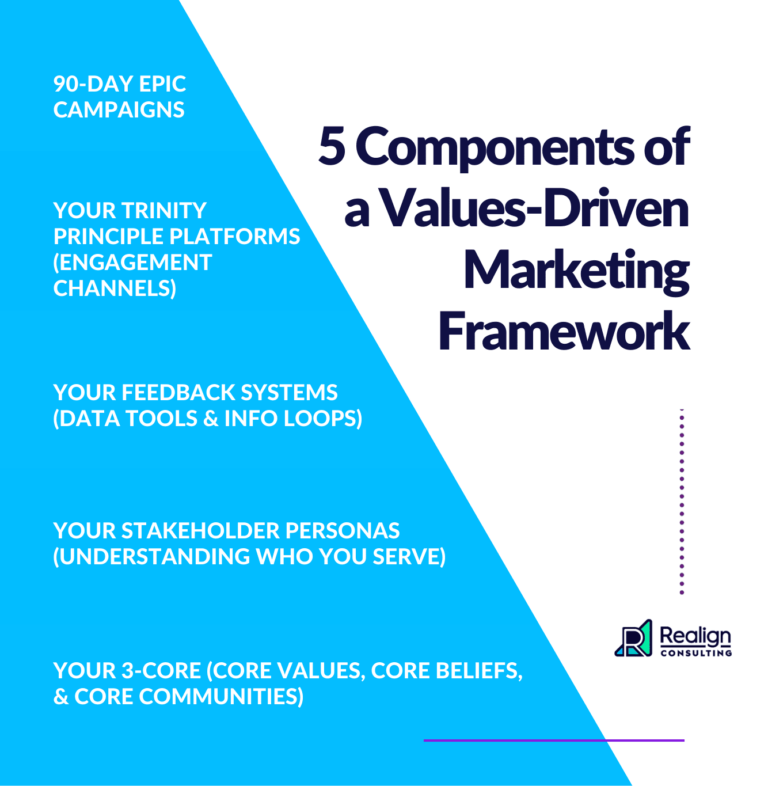Sustainable Marketing Strategies for Small Businesses: Growing Revenue and Community Impact
How can small businesses thrive in an ever-evolving marketing landscape while positively impacting their industries and society? The answer lies in sustainable marketing. In this post, we will explore the power of sustainable marketing for small businesses, the long-term benefits, cost-effective strategies, and how to appeal to conscious consumers. Join us on this journey towards driving growth while making a difference for humans.
Modern marketing has largely been defined by short-term thinking with a focus on temporary benchmarks such as…
- virality,
- growth hacking,
- micro conversions,
- sprint cycles, and
- quarter-over-quarter growth.
In addition, the rapid pace of technological change has led to an industry that’s seen alarming rates of burnout over the last decade.

When I began my career in digital marketing around 2009, marketing jobs were often seen as lifestyle jobs. We could balance our lives around good work, especially in the emerging digital world.
That is no longer the case. Most of the marketers I know put in 70-hour work weeks and live constantly anxious about the demand for ever higher performance. This, while operating in a sphere that much of the rest of the business world still sees as a “soft”—not as serious as sales or production.
Marketers are exhausted, anxious, and looking for a new way to work.
According to a study conducted by Oracle, 75% of the over 7,000 marketers surveyed reported high levels of burnout. Some are leaving the industry entirely to escape the pressure.
Others, like our team at Realign Consulting, began to develop a new way of marketing that more effectively paces growth efforts to make both the business and the marketers who serve it more sustainable.
We call this remembered way (because it’s not new; we just forgot how to do it) sustainable marketing.
The way to a more sustainable form of business growth begins with a values-driven marketing framework, but that’s only one part. It’s still possible to be values-driven and anxiety-ridden. In fact, it’s becoming more and more common in socially conscious companies.
Sustainable marketing is about more than green initiatives or social consciousness. It’s a choice to think long-term about the human impact of the way we grow our businesses.

Keep reading to learn more about how sustainable marketing is transforming the work of both marketers and the businesses they serve.
If you’re missing a sense of ease and expansiveness in your work, the shift to sustainable marketing could be just what you’re looking for.
When we’re shifting a business from hyper-drive to sustainably-minded, the first and most fundamental shift is this:
Sustainable businesses put all stakeholders at the center, not just shareholders.
Traditional marketing says, “It’s not personal. It’s business.” Sustainable and values-driven marketing says, “Because we’re humans who need humans, business can’t be anything but personal.”
I went straight into small business banking as a fresh-faced college grad. While I excelled in my position (becoming the youngest VP at the company then), I also became worn down by the cutthroat environment and never-ending hustle culture.
I knew there had to be a better way, but it took the 2007/2008 financial crisis to bring things into perspective.
Though my job was secure, I wanted to find a more personal and sustainable way to help small businesses in my community. So, I struck out on my own.
I soon became involved in a local business networking group whose methods would forever change how I (and my clients) do business.
In banking, the focus was on the short-term, jumping from sale to sale in a seemingly endless effort to keep up the numbers.
This local business group focused instead on referral-based marketing, a long-term focus that eliminates the need for constant hustle. This strategy operates on the idea that building relationships over time has a compounding and mutually beneficial effect on your business and community.
Instead of constantly chasing new customers, most of a business’s effort goes to building strong relationships with established customers through repeated, timely sales.
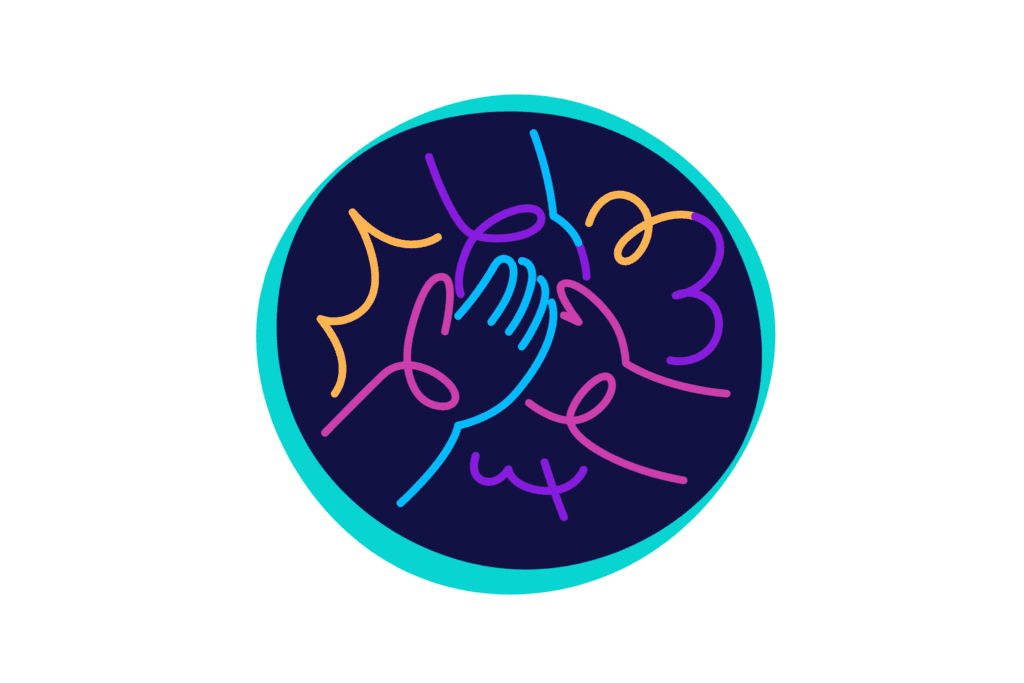
The result: a self-sustaining business pipeline that didn’t require nearly as much effort to maintain.
The choice was clear to me: Build your business by taking what you can get or choose to build the business by giving what you can.
It’s been 25 years since SEO and other forms of internet marketing began to transform what it means to seek the attention of consumers. That means we are just starting to have enough distance to truly understand the impact of this transformation. It’s time we face a core truth about the constant growth hacking and hustle: It’s unsustainable.
In a world where AI-driven production is transforming what it means to be in creative or strategic professions, the future of business requires a different approach. For small businesses, the shift to sustainable, values-driven marketing is critical to survival.
The original promise of digital marketing—that it could level the playing field and democratize business—has proven woefully untrue. When small businesses compete head-to-head with corporate giants, they mostly lose. Small businesses win by doing what their larger competitors cannot or will not: focusing on all stakeholders.

A company’s stakeholders are those with a vested interest in the business, such as employees, customers, shareholders and/or owners, vendors, and their families. This group also includes the community where the business is located if it uses the resources of that community.
Business is about people. Organizations that serve only shareholders will always struggle to take a sustainable approach to growth.
Sustainability in marketing is, at its core, a choice to think of a bigger picture than the right-this-moment metric.
The concept of sustainability is a bit of a buzzword right now. Yet, few marketing professionals take the time to explore the core meaning of the term and how it connects with business and marketing beyond green initiatives.
Most definitions of sustainable marketing focus entirely on the planetary aspects. These definitions, while transformative, are limiting. I believe our disregard for the planet’s health is rooted in a deeper dysfunction that we cannot solve by addressing climate issues alone.
It is not enough for a marketing team to seek out greener servers to host their digital tools or consider energy outputs for their events. We must address the more profound dysfunction at the heart of modern marketing: the belief that shareholder profits are the highest and best purpose of the marketing function.
Sustainable marketing, like sustainable agriculture or energy, considers the long-term impact on the psychology and health of today’s customers and the customers that will live 100 years from now. It is a recognition of what businesses of the past knew and that we have forgotten in the digital age: Legacy matters.
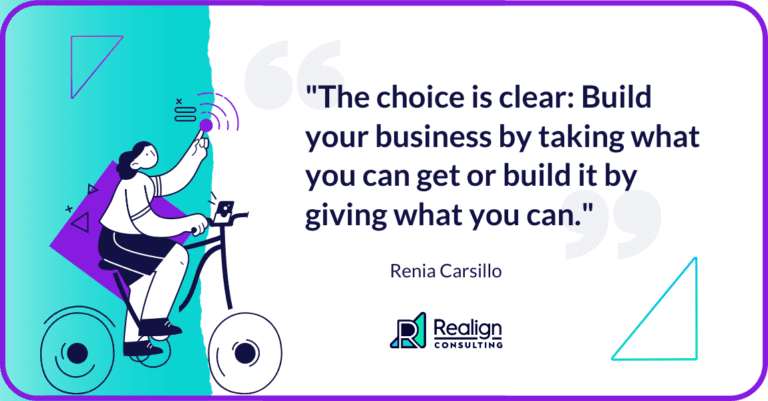
What is Sustainable Marketing?
At Realign Consulting, this is how we define Sustainable Marketing:
- Sustainable Marketing is the choice to prioritize long-term healthy outcomes over immediate results. It balances people, profit, and global impact as equally important factors in defining a company’s success rather than strictly considering profit, as is currently the case for most marketing departments.
Sustainable Marketing supports sustainable business scaling in expanding a business’s purpose to include serving ALL stakeholders, not just shareholders. That means that a sustainably designed marketing strategy is built on a values-driven framework and considers the first and most foundational rule of human-aligned marketing:
First, do no harm.
To do no harm is not limited to the messaging or ads of the moment. Instead, it considers the psychological, environmental, and growth implications of the choices made today on the consumers of the future.
Okay, so what isn’t sustainable marketing? How is what we’re doing today a problem?
Sustainable marketing isn’t just about eco-friendly products or messages. And it isn’t necessarily slow. Instead, it’s a willingness to slow down and consider more than just profit as worthy of attention. As Tristan Harris puts it when talking about AI, it looks at the incentives and seeks ways to shift them if they are not aligned with the company’s values.
A prevalent example of how much harm we do when we don’t consider sustainability when designing a marketing strategy is the absolute clusterfuck that is modern social media.
Early in my self-employment journey, I earned much of my initial traction through a 2009-era Facebook page where all your followers would see every post you made. So, by the time social media became the dominant force for brand growth, my rose-colored glasses were firmly in place.
What better way to build relationships with your customer base than through social media?
It may seem unbelievable to businesses today, but there was a time before paid ads and mysterious algorithms when Facebook pages could easily see 98% organic reach based solely on the strength of their messaging.

I saw first-hand social media’s power to connect people with similar worldviews and shared values. These connections created a customer base and referral pipeline strong enough to support a business’s continued growth without resorting to manipulative tactics.
In fact, I coached my early clients to devote their digital marketing resources to social media as a highly effective way to grow their businesses.
Then, as the saying goes, marketers ruined everything.
Five years after I launched my business with a Facebook page and a determination to do better, social media looked a lot like the toxic banking environment I had left behind.
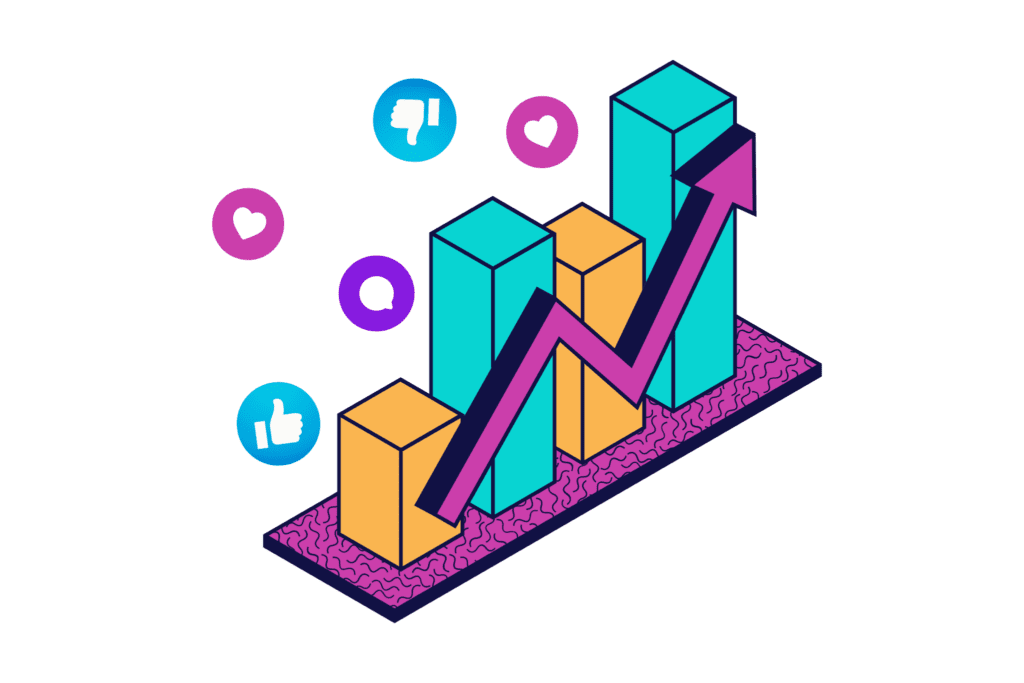
Instead of focusing on building relationships, marketing on social media became about short-term gains.
Every feed was populated with clickbait, tripwires, and emotional manipulation. Page owners were forced to play the game or lose their hard-earned customer base.
These tactics created many unhappy people in the banking industry. I could see the same thing happening to the business owners I was trying to help.
Though I didn’t have a name for it yet, these experiences helped me shape the idea of a values-driven marketing framework as the scaffolding for a sustainable approach to business growth.
For many of us, profits are not enough. We went into business for ourselves, entered a disrupting field, or chose to help grow a brand because we care about something bigger than ourselves. We want to make waves and change the tide—to make an impact.
If you can relate, you’re going to need a healthy dose of sustainable courage to survive.
Courageous actions in a single moment get the glory, but they don’t fuel ongoing progress so that we can move forward. For values-driven marketing to work, we need sustainable courage.
What does it mean to have sustainable courage? It means…
- Leading from our values as individuals and as company leaders
- Understanding risk in terms of mitigation, timing, and sustainability
- Asking for help when we need it
Of the three, asking for help is probably the hardest thing for many of us to do. Our goals for our businesses are so personal, and it’s hard to trust others to be as committed to seeing things through.
As business leaders, we must also understand the true nature of risks.
Sustainable courage isn’t foolish. While some risks may be necessary for business, failure does not have to be a business-ending event.
The risk-takers we admire are successful because they do three things:
- They take precautions to mitigate potential negative outcomes.
- They are patient and strategic about timing.
- They make changes that are sustainable for themselves and their teams.
If you’d like to learn more about mitigating risks, I discuss the five keys to effective risk-taking here.
To build a sustainable marketing strategy, we must follow many of these same steps.
The 5 Principles of Sustainable Marketing
Sustainable marketing is very different from the tactics-based work of most marketers. Today’s executives and founders often demand almost real-time results from their marketing teams, with little regard for any objectives other than the now.
The constant demand for growth at all costs is at the heart of why so many marketers feel burned out—and why so many consumers feel like they’re constantly battling against ever-more-aggressive marketing messaging and advertising.
Sustainable marketing must adhere to five basic principles. These are:
- Serve long-term brand values, first
- Build on a Values-Driven Marketing Framework
- Be integrated into and well-understood by all areas of the company
- Focus on word-of-mouth and referral-based marketing strategies
- Honor the cyclical nature of growth
As previously stated, we begin with the commitment first to do no harm. Then, marketers must understand the long-term vision and mission of the brand and what stakeholders feel and desire from the company.
Once we understand the long-term designs of the organization and its products, we have a solid foundation on which we can build a company-specific values-driven marketing framework.
Structuring our marketing like this has two major benefits:
- This structure makes integrating messaging into the way stakeholders speak about and interact with the brand easier and more authentic. This allows for word-of-mouth and referral-based marketing strategies to work their magic.
- This deep understanding of the company and its values means that teams plan for and are willing to accept the inevitability of growth cycles. Sustainability becomes not only possible but the most likely outcome.
Now, let’s look at each principle of sustainable marketing a little bit closer.
Sustainable Marketing Principle #1: Marketing is in service to long-term brand values first, not quarterly profits.
The digital age has enabled marketers and the advertising industry to drive micro-actions in the most granular of ways. This micro-thinking led to ever greater specificity and individuation of ads and messaging over the last two decades.
Some of that has been good.
Micro-targeting can lead to well-timed and welcome advertising, like when I was headed out of town for a concert and saw an ad for a new restaurant down the street from the venue (I love trying out new food).
Macro-targeting has led to the sprouting of thousands (maybe millions) of micro-niche businesses that can build community in a way that was not possible before.

But beyond the manipulation we’ve already touched on in this piece, this drive towards manipulating micro actions has led many marketers and the executives they report to to think in shorter and shorter terms.
Long-term thinking often gets pushed to the side when short-term thinking in the marketing department is paired with shareholder demands for quarter-over-quarter profits.
Over time, this misalignment of priorities can keep an unknown brand from finding loyal and sustainable traffic—or a well-known one to create customer whiplash that opens doors for competitors to step in.

The most common mistake I see marketers make is chasing tactics and micro-actions with little attention to the overall brand framework. It’s the business equivalent of fad dieting—creating short-term results that never stick and likely have unintended consequences.
The fix for this hamster wheel isn’t easy, but it is simple: Long-term branding based on values is priority number one. Never sacrifice the core brand for short-term gains.
That doesn’t mean that short-term goals and campaign-level hustle are not a necessary part of the work; they are sometimes. But not all the time, and never at the expense of the bigger picture of what your brand is to its stakeholders.
Sustainable Marketing Principle #2: The Marketing Plan must be built on a Values-Driven Marketing Framework.
There are plenty of tactical strategy frameworks that a brand can (and sometimes should) engage with. From acronyms like ABM and AIDA to friendly-name frameworks like Storybrand and The Blue Ocean Strategy, there are plenty of ways to frame the methodology and tactics of your marketing framework.
But I believe that to be truly sustainable in the modern AI and algorithmically-driven world, whichever system you choose must be built with the values-driven framework as its foundation and scaffolding.
Only a solid organizational tie to core values and communities can counterbalance the constant pull to “more” that is the late capitalist model we’re all working within.
Sustainable Marketing Principle #3: Marketing is the heartbeat of the company, not an appendage. The marketing framework must be integrated into the business and well-understood by the people working within it.
It’s been a very long time since positioning the work of marketing a company or its products as a separate department was a sustainable way to organize. In a world where every employee, customer, vendor, or neighboring company has the power to raise or drag down your brand in their pocket, the marketing team cannot exist in a silo.
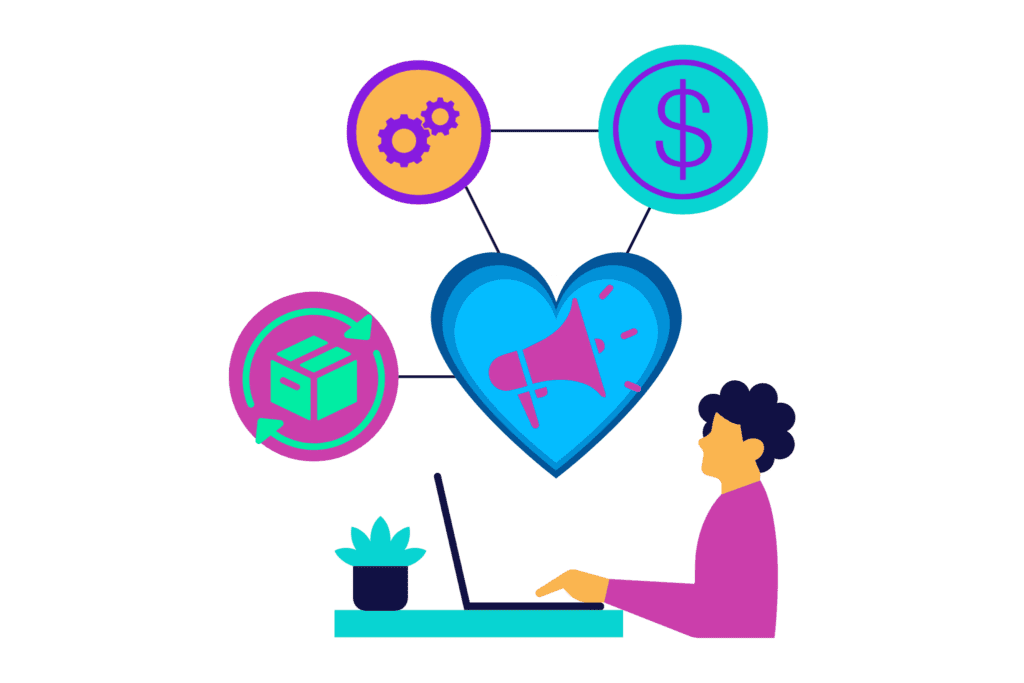
Brand messages, marketing frameworks, stakeholder personas, and campaign-level messaging must be regular parts of the organization and its culture. Marketers are not minions. They’re curators of what a company is and can be to the outside world and internal teams alike.
Almost ten years ago, Hubspot popularized the term “Smarketing” to describe the need to bring sales and marketing functions together, and some progress has been made. But even if your organization has created a connection in these two spaces, that’s not nearly far enough.
Your branding and the marketing in service to it must be informed by, created with, and well-understood by the entire organization to maintain values alignment and long-term sustainability.
Sustainable Marketing Principle #4: Be deeply concerned with word-of-mouth and referral-based marketing strategies.
All sustainable marketing relies on both organic word-of-mouth and intentional referral-based marketing strategies. This truth existed long before social media and search engines, or even TV commercials and billboards. I might be so bold as to say that word-of-mouth and referral strategies are the oldest form of marketing. And it’s stuck around for so long for a reason.
I believe deeply in formal, informal, and individualized referral-based marketing strategies. It never ceases to confound me that 92% of American consumers say they rely on personal referrals, and 89% of B2B buyers say they do, yet only 30% of American companies report having a formal referral program. The statistics on individualized training and reporting strategies for salespeople, customer service teams, and other employees are even more abysmal.
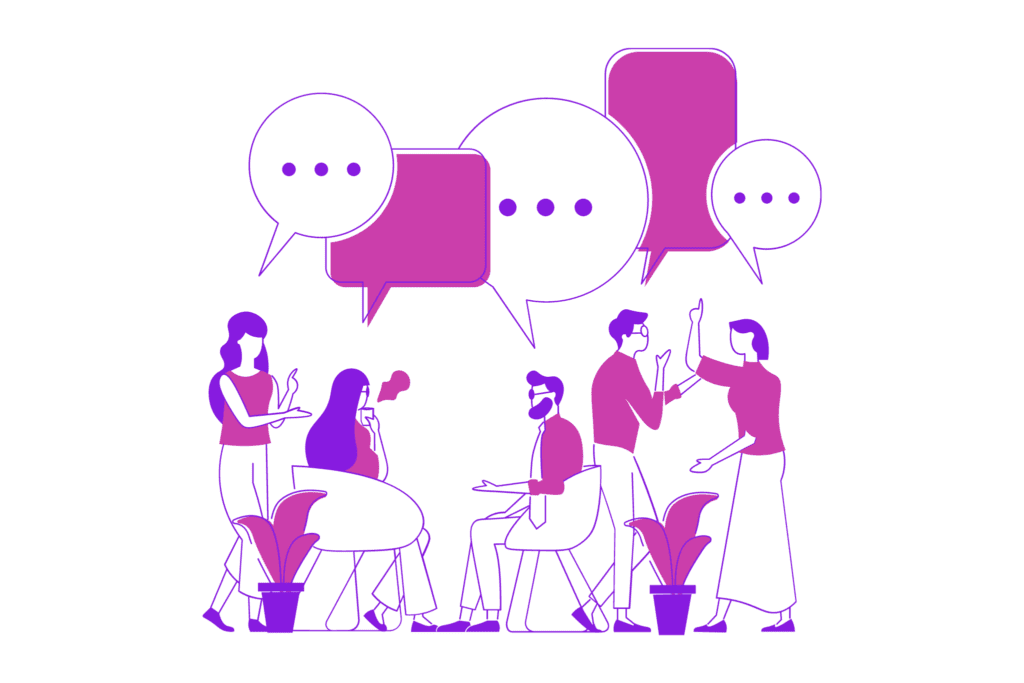
To be abundantly clear, there is no more sustainable marketing tactic than a well-built and intentionally nurtured referral program. Sustainability is not possible for most small and mid-sized companies without paying significant attention to word-of-mouth strategies.
Sustainable Marketing Principle #5: Always design with cycles in mind.
No offense to my JCPenney’s manager circa 2001, but the idea of constant campaigns is not sustainable. As the organization itself would find out—in a gory downward spiral that began right around the time of that conversation (obviously, not correlated) and culminated with a 2020 bankruptcy filing that surprised precisely no one.
As JCPenney and countless other retailers have learned, constant sales are not the secret sauce that saves a company. And running even more elaborate and noisy campaigns won’t either.
Unless we’re in the business of selling commodities, constant campaigning, especially with discounts and sales, is not the path toward sustainable growth (or having any fun). Instead, sustainable marketing requires taking a step back from the day-to-day and planning for cycles of heavy growth and cycles of building and/or rest.
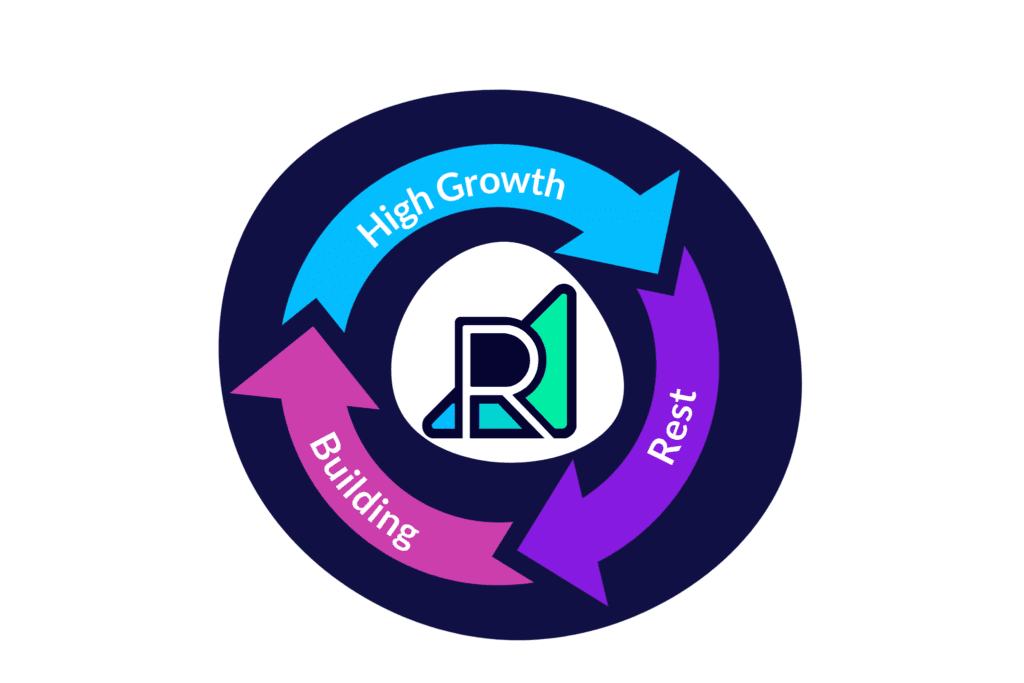
In our company, we do this by intentionally blocking out spring and fall as high growth times. We reserve the searing hot summer months and slower times of winter for building new offerings, creating longer-term collateral, and generally slowing down. For us, the seasonality works well.
For your organization, this might flow in production cycles (made famous by Basecamp), business seasonality (accountants come to mind), or in a less formal way on market conditions (like an unexpected trend driving new opportunity).
However you organize your cycles, they don’t happen without an intentional step back. That’s why we like to see marketing teams hold two-day strategy retreats every 12-18 months to align their cycles with the overall business strategy and prepare for intentional times of building, hustling, and resting.
Am I taking the right approach to sustainable marketing?
By this point, you might be asking yourself if your marketing strategy is built on a sustainable framework or on the path to get to sustainability someday. To help break this down, I’ve created this quick comparison for evaluating your marketing efforts and those of your team:
Sustainable Marketing
- Our team is deeply committed to our core values and understands how to convey them in our work.
- We have a well-documented marketing framework that includes stakeholder personas, core messaging, brand frameworks, etc.
- The marketing function is well integrated with sales and other parts of the company.
- Innovations, industry changes, and new opportunities are constantly being evaluated, experimented with, and embraced when they align with our values-driven framework.
- Marketers work at a steady pace, sometimes more or less hustle, but generally around 32-42 hours per week.
- Before implementing a new tactic, we first evaluate the unintended impact on humans, animals, and/or the planet.
- We have a thoughtfully designed referral-based marketing strategy with programs for both customers and internal teams.
Unsustainable Marketing
- No one is sure what we stand for. We have a vague statement on our website, but it isn’t part of our day-to-day work.
- We create things one campaign at a time. It’s not worth the energy, effort, and cost to stop and create one unifying framework or strategy.
- Marketing and sales are constantly bickering. The rest of the company doesn’t really take marketing seriously.
- It takes years to change tactics. On the other hand, things change every other day. We try new things without any thought of whether or not the tool, tactic, or strategy aligns with our values.
- Marketers are constantly anxious and stressed out. The expectation is that if you're not putting in 50 hours or more, you’re not serious about your job.
- We use pretty much any tactic that creates shareholder growth. No other metrics matter except efficient sales.
- Referrals and word-of-mouth are happy accidents. We don’t believe this is something that can be structured.
How do I start adopting sustainable marketing strategies in my business right now?
The first step to building a more sustainable marketing strategy is to evaluate where you are now. For solopreneurs and micro businesses, assessing what type of business you are building with our Brand Archetype Quiz is a great place to start.
If you have a marketing team inside your organization (even if that team is just one person) or work with contractors and agencies, the best place to begin is with a Strategic Marketing Retreat.
This process brings in an outside set of eyes, ears, and facilitation skills to help your team determine where you’re at and where you want to go with your sustainability efforts and design a 12-18-month GPS-style flexible path to get there.
By engaging an external perspective while taking time away from the day-to-day, you’ll quickly establish where your growth edges are and where you’re already more successful than you might think.

If you’ve spent most of your professional life feeling a little (or a lot) stressed out about marketing, I hope this piece offers you a new path forward.
Next steps
Step away for two days to realign with your team at a Strategic Marketing Retreat.
It’s easy to get so busy Doing that we don’t set aside the necessary time for Designing. Our strategy retreats give you the space to realign your goals and create an achievable action plan for what comes next.

